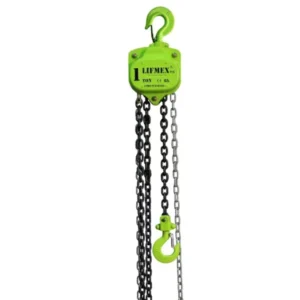Having the right equipment can make all the difference.
And that’s where the Chain Block comes in. Often overlooked, this unsung hero of the worksite is a powerful tool that can transform your heavy lifting operations. With its robust design and reliable performance, a manual chain block provides a safe and efficient solution for moving heavy loads. Whether you’re working in construction, manufacturing, or any industry that involves heavy lifting, this versatile device can save time, improve productivity, and ensure the safety of your workers. The beauty of a manual chain block lies in its simplicity. With a strong chain and a sturdy hand-operated mechanism, it allows you to lift, lower, and position heavy objects with ease. Its compact size and portability make it ideal for confined spaces, and its durable construction ensures long-lasting performance, even in the harshest of environments. Say goodbye to back-breaking labor and hello to increased efficiency and productivity with a manual chain block. Discover how this often overlooked piece of equipment can revolutionize your worksite and take your heavy lifting operations to new heights.
Advantages of Using a Chain Blocks
Versatility
Manual chain blocks are versatile tools that can be used in a wide range of industrial or worksite applications. They are suitable for lifting, pulling, and positioning heavy loads in various environments, including construction sites, warehouses, factories, and workshops.
Durability
Manual chain blocks are typically constructed from robust materials such as steel, making them durable and capable of withstanding heavy-duty use. Their sturdy construction ensures longevity, allowing them to endure harsh working conditions and frequent usage without compromising performance.
Ease of Use
One of the key advantages of manual chain blocks is their simplicity and ease of operation. They feature straightforward mechanisms that are easy to understand and operate, requiring minimal training for users. This ease of use translates into increased efficiency and productivity on worksites, as operators can quickly and safely maneuver loads with minimal effort.
Cost-effectiveness
Manual chain blocks offer a cost-effective solution for lifting heavy loads compared to other powered lifting equipment. They require no electricity or fuel to operate, reducing ongoing operational costs. Additionally, their initial purchase price is often lower than that of powered alternatives, making them a budget-friendly option for worksites with limited resources.
Suitability for Confined Spaces
Manual chain blocks are well-suited for lifting heavy loads in confined spaces or areas with limited access. Their compact size and ability to lift loads vertically make them ideal for tasks where traditional lifting equipment may not be feasible. This versatility enables operators to tackle challenging lifting scenarios with ease, maximizing workspace efficiency.
Increased Productivity
Manual chain blocks contribute to increased productivity on worksites by facilitating quicker load lifting and positioning. Their efficient lifting mechanisms enable operators to complete tasks more rapidly, reducing downtime and improving workflow. As a result, worksite operations can be completed more efficiently, leading to overall time and cost savings.
Reduced Strain on Workers
By handling the heavy lifting tasks, manual chain blocks help reduce physical strain and fatigue on workers. This can lead to improved employee morale, reduced risk of musculoskeletal injuries, and enhanced overall safety in the workplace. By minimizing the physical burden on workers, manual chain blocks contribute to a healthier and more productive workforce.
Improved Safety Measures
Manual chain blocks are equipped with safety features such as load-limiting devices, safety catches, and brake mechanisms to prevent accidents and ensure safe operation. These safety measures help protect both workers and equipment from harm, minimizing the risk of accidents, injuries, and property damage. By prioritizing safety, manual chain blocks provide peace of mind to operators and enhance worksite safety standards.
Key Features of a Chain Blocks
Load Capacity
The load capacity refers to the maximum weight that a manual chain block can lift safely. It is essential to consider the weight of the loads typically handled in your worksite to ensure that the manual chain block can accommodate them without exceeding its capacity. Manufacturers provide load capacity ratings for their manual chain blocks, typically ranging from a few hundred kilograms to several tons.
Lift Height
Lift height refers to the maximum distance that the load can be lifted vertically using the manual chain block. This feature is crucial for determining the suitability of the manual chain block for specific lifting tasks, especially in applications where significant vertical clearance is required. Manual chain blocks are available with various lift heights to accommodate different worksite requirements.
Construction Materials
The construction materials used in a manual chain block determine its durability, reliability, and resistance to wear and tear. High-quality manual chain blocks are typically constructed from robust materials such as alloy steel or hardened steel components. These materials ensure the strength and longevity of the manual chain block, even when subjected to heavy-duty use in demanding work environments.
Safety Mechanisms
Safety mechanisms are integral features of manual chain blocks designed to prevent accidents and ensure safe operation. Common safety mechanisms include:
-
- Brakes: Braking systems are essential for controlling the descent of the load and preventing it from free-falling.
- Overload Protection: Overload protection devices prevent the manual chain block from lifting loads exceeding its rated capacity, reducing the risk of equipment damage and operator injury.
- Safety Hooks: Safety hooks are designed to securely attach the load to the manual chain block and prevent accidental disengagement during lifting operations.
- Load-Limiting Devices: Load-limiting devices provide visual or audible indicators when the load approaches or exceeds the maximum capacity, alerting operators to potential safety hazards.
- Ergonomic Design: Ergonomic design features enhance the usability and comfort of manual chain blocks, reducing operator fatigue and improving efficiency. Ergonomic handles, lightweight construction, and smooth operation mechanisms contribute to a user-friendly experience. Additionally, ergonomic design considerations ensure that operators can handle manual chain blocks safely and effectively, even during prolonged use.
How to Choose the Right Chain Blocks for Your Needs
- Identify Your Lifting Requirements
- Determine the types of loads you will be lifting with the manual chain block. Consider factors such as weight, dimensions, and shape of the loads. This information will help you determine the required load capacity and lift height of the manual chain block.
- Assess Frequency of Use:
- Consider how often the manual chain block will be used in your operations. For frequent or continuous use, you may need a more durable and heavy-duty manual chain block. Conversely, occasional or intermittent use may require a lighter-duty option.
- Evaluate Working Environment Conditions
- Assess the environmental conditions in which the manual chain block will be used. Factors such as temperature extremes, moisture, dust, and corrosive substances can impact the performance and longevity of the equipment. Choose a manual chain block with materials and coatings that can withstand the specific environmental conditions of your worksite.
- Consider Safety Requirements
- Prioritize safety features and mechanisms when selecting a manual chain block. Ensure that the manual chain block is equipped with adequate safety features such as brakes, overload protection, safety hooks, and load-limiting devices. Compliance with relevant safety standards and regulations is also essential.
-
Budget Constraints
- Determine your budget for purchasing a manual chain block. While cost is an important consideration, it’s essential to strike a balance between affordability and quality. Avoid compromising on safety or performance by opting for cheaper, lower-quality options. Instead, invest in a manual chain block that offers the best value for your budget while meeting your lifting requirements.
- Consult with Industry Expert
- Seek advice from industry experts, such as equipment suppliers or experienced professionals in your field. They can provide valuable insights and recommendations based on their expertise and knowledge of manual chain blocks. Discuss your specific lifting needs, worksite conditions, and safety requirements to receive tailored recommendations.
- Conduct a Thorough Needs Assessment
- Conduct a comprehensive needs assessment to determine the precise specifications and features required in a manual chain block. Consider factors such as load capacity, lift height, safety features, and compatibility with existing equipment or infrastructure. This assessment will help you narrow down your options and select the most suitable manual chain block for your needs.
Proper Usage and Safety Guidelines for Chain Blocks
- Pre-operation Equipment Inspections
- Before using a manual chain block, operators should conduct thorough pre-operation inspections to ensure that the equipment is in good working condition. This includes checking for any signs of damage, wear, or defects in components such as chains, hooks, and brakes. Any issues should be addressed promptly before proceeding with operations.
- Proper Lifting Techniques
- Proper lifting techniques are essential for safe and efficient operation of manual chain blocks. Operators should be trained to use correct lifting techniques, including maintaining proper posture, avoiding sudden movements, and distributing the load evenly. Using the appropriate hand signals and communication methods between operators can also enhance safety during lifting operations.
-
Securing Loads
- Securing loads properly is critical to prevent accidents and ensure stability during lifting operations. Operators should verify that the load is securely attached to the manual chain block using appropriate hooks or attachments. Additionally, ensuring that the load is balanced and centered on the lifting mechanism helps prevent it from shifting or becoming unstable during lifting.
- Load Capacity Limits
- Operators must adhere to the specified load capacity limits of the manual chain block to prevent overloading, which can lead to equipment failure and accidents. It’s essential to know the maximum weight that the manual chain block can safely lift and never exceed this limit. Load capacity limits should be clearly marked on the equipment and referenced during operations.
- Importance of Operator Training
- Proper training is essential for operators to understand how to use manual chain blocks safely and effectively. Operators should receive comprehensive training on equipment operation, safety procedures, and emergency protocols. Training should cover topics such as equipment inspection, proper lifting techniques, load capacity limits, and emergency shutdown procedures. Regular refresher training sessions can help reinforce safe practices and ensure that operators remain competent in their roles.
Maintenance and Care for Chain Blocks
- Routine Inspections
- Regular inspections are crucial to identify any signs of wear, damage, or deterioration in the manual chain block. Operators should conduct visual inspections before each use to check for loose bolts, damaged components, or excessive wear on chains and hooks. Additionally, periodic thorough inspections by qualified personnel should be scheduled to assess the overall condition of the equipment.
- Lubrication of Moving Parts
- Proper lubrication of moving parts helps reduce friction, prevent corrosion, and maintain smooth operation of the manual chain block. Operators should follow manufacturer recommendations for lubricating key components such as chains, gears, and bearings. Using the appropriate lubricants and applying them according to the recommended intervals ensures optimal performance and extends the lifespan of the equipment.
- Addressing Signs of Wear or Damage Promptly
- Operators should promptly address any signs of wear, damage, or malfunction to prevent further deterioration and ensure the safety of the equipment. They should be trained to recognize common signs of wear, such as elongation of chains, deformation of hooks, or unusual noises during operation. Promptly replacing worn or damaged components and conducting necessary repairs helps maintain the reliability and safety of the manual chain block.
-
Creating a Maintenance Schedule
- Establishing a regular maintenance schedule ensures that maintenance tasks are performed consistently and on time. This schedule should include routine inspections, lubrication, and any other maintenance tasks recommended by the manufacturer. Operators should adhere to the maintenance schedule and document all maintenance activities for reference and compliance purposes.
- Identifying Potential Issues
- Operators should be vigilant in identifying potential issues or areas of concern during inspections or operation. This includes observing any changes in the performance or behavior of the manual chain block, such as increased resistance during lifting or unusual vibrations. Identifying potential issues early allows for timely intervention and prevents more significant problems from developing.
- Performing Minor Repairs
- Train operators to perform minor repairs or adjustments as needed to maintain the functionality of the manual chain block. This may include tightening loose bolts, replacing worn components, or adjusting tension on chains. However, for more complex repairs or issues, operators should consult with qualified technicians or manufacturers to ensure proper resolution.
Common Misconceptions About Manual Chain Blocks
- Safety Concerns
- One common misconception about manual chain blocks may be related to safety concerns, such as doubts about their reliability or fear of accidents. This section aims to address these concerns by highlighting the safety features and mechanisms built into manual chain blocks, such as brakes, overload protection, and safety hooks. By emphasizing the importance of proper usage and adherence to safety guidelines, readers can gain confidence in the safety of manual chain blocks for lifting operations.
- Limitations in Functionality
- Another misconception may revolve around the perceived limitations in functionality of manual chain blocks compared to powered lifting equipment. This section can dispel this misconception by highlighting the versatility and effectiveness of manual chain blocks in various lifting applications. Readers can learn about the diverse range of tasks that manual chain blocks can handle, including lifting heavy loads, pulling, and positioning, making them valuable tools in different worksite environments.
-
Suitability for Specific Tasks
- Some individuals may mistakenly believe that manual chain blocks are not suitable for certain tasks or industries. However, this section can debunk this misconception by providing examples and case studies showcasing the effectiveness of manual chain blocks in diverse industrial applications. Real-world success stories and practical examples highlight how manual chain blocks can effectively utilize in various worksite scenarios, from construction sites to manufacturing facilities.
- Cost-Effectiveness
- There might be a misconception regarding the cost-effectiveness of manual chain blocks compared to powered lifting equipment. This section can clarify that manual chain blocks offer a cost-effective solution for lifting heavy loads, as they require no electricity or fuel to operate and have lower initial purchase costs. By emphasizing the long-term value and return on investment of manual chain blocks, readers can recognize them as viable and economical lifting solutions.
- Maintenance and Durability
- Some individuals may underestimate the maintenance requirements and durability of manual chain blocks. However, this section can address this misconception by highlighting the importance of regular maintenance and care to prolong the lifespan and ensure the continued reliability of manual chain blocks. Additionally, by providing practical tips and guidelines for maintenance, readers can understand how to properly care for their equipment and maximize its longevity.
Where to Purchase High-Quality Manual Chain Blocks
- Factors to Consider When Selecting a Supplier
- Readers are advised to consider several factors when selecting a supplier to ensure they receive high-quality manual chain blocks and satisfactory service:
- Product Warranties: Suppliers offering generous warranties provide assurance of product quality and reliability. Readers are encouraged to inquire about warranty terms and conditions before making a purchase.
- Customer Reviews: Reviews and testimonials from previous customers offer valuable insights into the reputation and reliability of suppliers. Therefore, readers should seek out reviews to gauge the experiences of other buyers and make informed decisions.
- After-Sales Support: Suppliers that offer comprehensive after-sales support, including technical assistance, repair services, and spare parts availability, ensure ongoing satisfaction and maintenance of manual chain blocks. Consequently, this fosters trust and confidence among customers.
-
Shabbir Enterprises’ Offerings


- Shabbir Enterprises is mentioned as a provider of manual chain blocks, offering both Manual Chain Blocks and Explosion-Proof Chain Blocks. Readers are informed about the range of products available, indicating the diversity of options offered by the supplier.
- Readers are encouraged to consider Shabbir Enterprises as a potential source for high-quality manual chain blocks. By doing so, they can leverage their offerings to meet their specific lifting requirements effectively.
For further insights or to discuss your unique requirements, we invite you to connect with us Explore the unparalleled expertise and quality solutions that Shabbir Enterprises brings to the table, ensuring your material handling equipment’s needs are met with precision and reliability.


